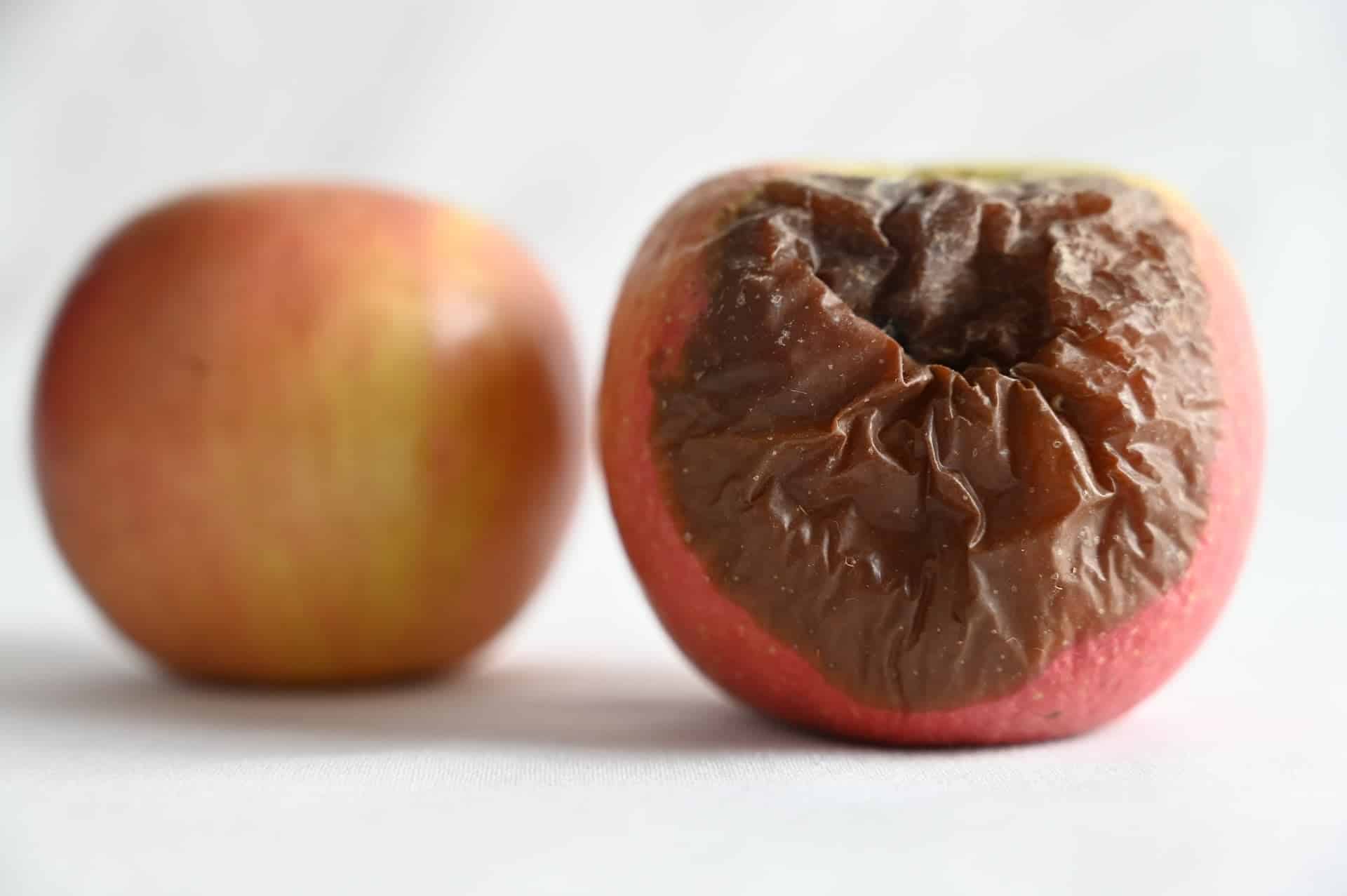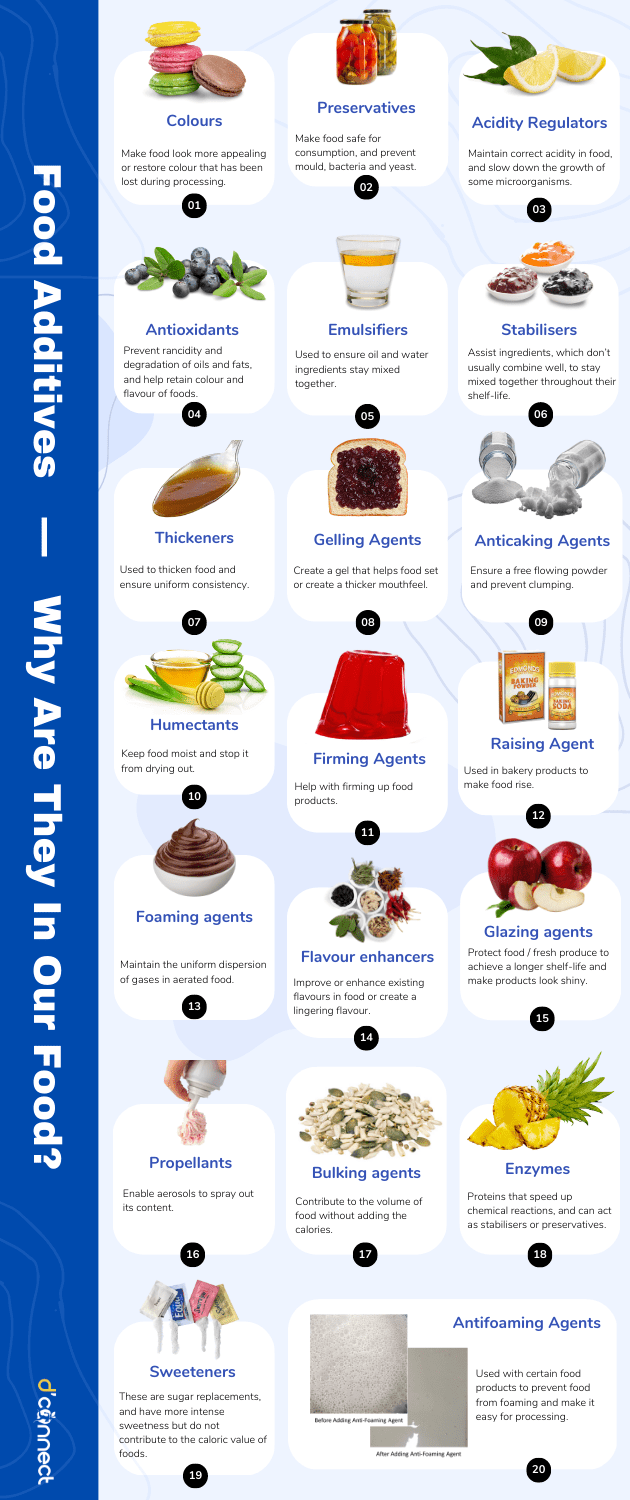
Julie Ilagan-Lee
(BSc Food Technology)
Food additives are something many don’t worry about, and yet when we enter our middle age and have families, we begin to be more careful about our health.
The last few years have made many of us more attentive about our mental and physical health and raised questions about our food, including the quality, processing and production, as well as misuse or overuse of food preservatives.
Today, we look more closely at the term and meaning behind food additives.
What are food additives?
Food additives are compounds added to commercial food products to retain their physical & sensory attributes, keep them stable, and ensure food is safe for consumption.[1]
They are also used to make food processing easier on a commercial scale.[2]
Food additives also make it possible to have
- a consistent supply of a particular produce all year round
- increased food sustainability
- less agricultural wastage[3]

In other instances, food additives are used for fortification of vitamins and minerals in food products.[4]
All food additives used are risk assessed by different governing bodies around the world such as Codex Alimentarius (FAO-WHO), Joint Expert Committee on Food Additives (JECFA), and Food Standards Australia New Zealand (FSANZ).
Section 15 of the Food Standards Code recommends a maximum permitted level in using these additives, and these levels are also known as “acceptable daily intake“ (ADI) as set by JECFA.[5,6]
Most additives follow an international numbering system
The numbers are sometimes used to make the label shorter, more importantly to avoid confusion for a similar sounding name.
In other food labels, these numbers are prefixed by an ”E” which denotes that it is labelled for the European Union market.[7]
Differences between food additives and food preservatives
Food additives are used in general to improve the quality of food, taste, appearance and keep food safe for consumption.
Food additives include other classes of compounds that have functions other than preserving food, which we cover in the next section.
Food preservatives belong to one of the classes of food additives. Food preservatives are used to protect food from bacteria, mould and yeast contamination.

Preservatives make the food last longer
They also ensure that food is safe to eat, and prevent quality degradation from microbial, enzymatic and physical-chemical reactions.[8]
Types of food additives (Classification and Function)
The Ministry of Primary Industries’ Food Additives Booklet has outlined the different classes of Food Additives which was approved by Food Standards Australia New Zealand.[6]
1. Colours make food look more appealing or restore colour that has been lost during processing.
2. Preservatives are used to make food safe for consumption, and also prevent food deterioration from mould, bacteria and yeast.
3. Acidity regulators include acids and alkalis that help maintain correct acidity in food, which also slows down the growth of some microorganisms.
4. Antioxidants prevent rancidity and prevent degradation of oils and fats. They can also help retain colour and flavour of foods rich in oil/fat.
5. Emulsifiers are used to ensure oil and water ingredients stay mixed together.
6. Stabilisers assist two or more ingredients, which don’t usually combine well, to stay mixed together throughout its shelf life.
7. Thickeners are used to thicken food and ensure uniform consistency. Examples include modified starches, gums and gelatin.
8. Gelling agents create a gel that helps food set or create a thicker mouthfeel. Some of them are carrageenans (used in chocolate milks and ice cream as an example) and pectins (used in jams).
9. Anticaking agents ensure a free flowing powder and prevent clumping of high moisture ingredients.
10. Humectants keep food moist and stop it from drying out.
11. Raising agents are used in bakery products to make food rise.
12. Firming agents help with firming up food products, or interact with gelling agents.
13. Foaming agents maintain the uniform dispersion of gases in aerated food (for example, light airy mouthfeel of a chocolate mousse).
14. Flavour enhancers improve or enhance existing flavours in food or create a lingering flavour.
15. Glazing agents protect food / fresh produce and help them achieve a longer shelf life and make products look shiny.
16. Propellants enable an aerosol to spray out its content.
These should be identified clearly on the label by its name rather than just a code number to serve as a warning for its combustibility. Having an E number also suggests that it has been assessed as food grade.
17. Bulking agents contribute to the volume of food without the calories.
18. Enzymes are proteins that speed up chemical reactions. They can act as stabilisers or preservatives.[9]
19. Sweeteners (artificial) are sugar replacers, and can be more intense in sweetness when compared to normal sugar and do not contribute to the caloric value of foods.[10]
RELATED — Artificial Sweeteners: Are they a Healthy Substitute to Sugar?
For example:
1 gram of Sugar = 4 Calories while 1 gram of Aspartame (E951) = 0 Calories.
20. Antifoaming agents are used with certain food products that when mixed together produce foam in large quantities. When added, antifoaming agents prevent food from foaming and make it easy for processing.
Do we really need food additives in our food?
If we are eating all fresh foods and are preparing all our food then we don’t need food additives.
However, if we need baking powder, or want to buy items like cheese and deli meats from the supermarket, most likely we will have food additives in our food.
Also, if we would like a reliable food supply for the increasing world population, and guarantee a supply of safe food to eat all year round, then we have to be all guilty of consuming food with additives.
Modern food science and technology is now aiming at producing foods with cleaner and simpler labels. Scientists and technologists are in a continuous search for the most effective and least intrusive ways of manufacturing food.
Due to the growing preference of people for cleaner and healthier food, now comes the emergence of
- natural flavours
- clean label starches
- natural preservatives
We are also becoming more aware of reading and selecting shorter ingredient labels, and ingredients that are healthier for both us and the planet.[11]
How do food additives affect our health
Food additives may or may not affect our health depending on the amount of consumption. As they say – the “poison” is in the dose.
All food when taken in excess could be bad for us. Having a balanced diet and sufficient physical exercise is always the key to good health.

The studies mentioned in this article regarding the effects of food additives have mainly been done on animal lab trials, and not proven on humans. FSANZ list of approved additives have been tested and found to be safe for human consumption.
Summary

Note — feel free to download and share this illustration.
Related Questions
1. What are natural preservatives?
The definition of “natural” has always been a topic of debate. Most people regard the term natural as something that does not contain an “E number” or a chemical sounding name.
In this case, there are a lot of natural preservatives available such as
- Celery juice powder (alternative to sodium nitrite used in processed meats)
- Cultured dextrose (fermented dextrose as alternative to calcium propionate or potassium sorbate as mould inhibitor in food).
2. Do food additives cause weight gain?
Some animal studies suggest that food additives cause weight gain.
Some additives tested mention BHT (butylhydroxytoluene), sometimes seen in breakfast cereals. This is commonly found in US food but is less used in Australia and New Zealand.[12]
3. Can I be allergic to food additives?
Yes, depending on the food additive. Food ingredient labelling stipulates declaration of any allergens that are present in food so it should provide the consumer with an allergen warning.
Allergens commonly associated with food additives are:
- Sulphites – present in sodium metabisulphite and sulphur dioxide
- Egg or soy – present in lecithin (emulsifier)
- Annatto colour – a rare cause of anaphylaxis (very few people are sensitive to this).[13]
We are currently working on a new series of articles regarding the production and processing of our food.
If you would like to know more about the articles that are coming out, please Subscribe to our Newsletter, and we’ll give you a sneak peek.
Julie has completed her Bachelor of Science in Food technology and now with over 20 years of local and international food industry experience, it’s safe to say that food and flavors are her life and passion.
Julie’s expertise are food ingredients, and their different food applications. She has a knack for savory flavors and functional ingredients in meat and plant based applications. Being a part of a food innovation space, she is exposed to the latest ideas and developments that are looking to solve issues in the New Zealand food industry, making it an exciting time for any food technologist. Especially the ones who are looking to educate more people about food technology and processing, like Julie does.
Julie’s focus for the future is to create new and innovative functional foods with “clean” and simple ingredients as possible, and prove that technology and nature can work together.
References
(1) Ministry of Primary Industries. (17 May 2020). MPI. Introduction to Food Additives. https://www.mpi.govt.nz/food-safety-home/food-additives-preservatives/introduction-to-food-additives-and-preservatives/
(2) World Health Organization. (31 January 2018). Food Additives. https://www.who.int/news-room/fact-sheets/detail/food-additives
(3) International Food Additives Council. (2022). Food Additives. https://www.foodingredientfacts.org/a-more-sustainable-food-supply/
(4) World Health Organization. (2022). Food Fortification. https://www.who.int/health-topics/food-fortification#tab=tab_1
(5) Australia New Zealand Food Standards Code. (1 March 2016). Schedule 15 Substances that may be used as food additives.
(6) Food Standards Australia New Zealand. (2021). FSANZ. Chemicals in Food.
(7) Food Additives & Ingredients Association. (2022). FAIA. Making Life Look and Taste Better. https://www.faia.org.uk/e-numbers/
(8) Garcia-Garcia, R. Searle, S.S. (2016). Encyclopedia of Food and Health. Preservatives: Food Use. https://www.sciencedirect.com/science/article/pii/B9780123849472005687
(9) European Food Safety Authority. (2021). Food Enzymes. https://www.efsa.europa.eu/en/topics/topic/food-enzymes
(10) New Zealand Food Safety. ( August 2022). Identifying Food Additives. https://www.mpi.govt.nz/dmsdocument/3433-Identifying-Food-Additives
(11) International Food Technology. (September 2021). The Changing Face of Clean Label. Food technology Magazine. https://www.ift.org/news-and-publications/food-technology-magazine/issues/2021/september/columns/ingredients-clean-label
(12) Rajhamani, U.,Gross, A., Ocampo,C. et al. (9 August 2017). Endocrine disruptors induce perturbations in endoplasmic reticulum and mitochondria of human pluripotent stem cell derivatives. Nature Communications. https://www.nature.com/articles/s41467-017-00254-8#article-info
(13) Nish WA, Whisman BA, Goetz DW, Ramirez DA. ( February 1991). National Library of Medicine. Anaphylaxis to Annatto Dye: A case report. https://pubmed.ncbi.nlm.nih.gov/1994783/






